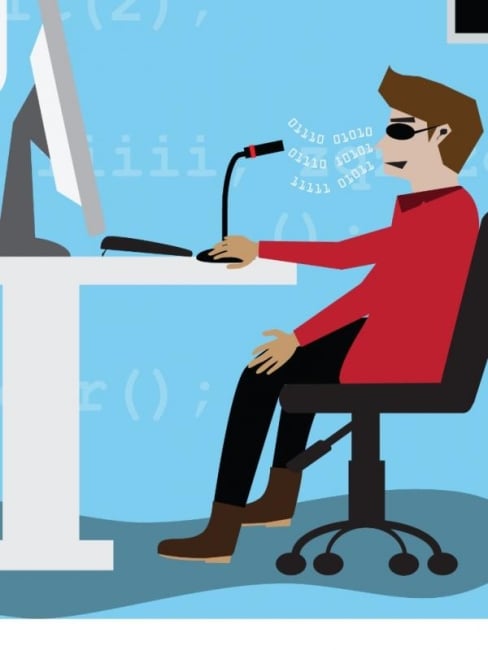You have /5 articles left.
Sign up for a free account or log in.

Istock.com/wilkat
In March 2020, we joined colleagues across the country in dealing with rapid changes to the courses we were teaching and taking. In many cases, instructors had little choice but to default to the same content and course structure that they used in face-to-face instruction, as time pressures precluded the opportunity to engage in careful online course design.
In our experiences -- those of one professor, two instructional support professionals and one graduate student -- we have seen firsthand that the haste with which courses were transitioned online placed one group at a particular disadvantage: students with disabilities.
Last spring, the use of platforms and content formats not optimized to meet the needs of students relying on assistive technologies amplified barriers to their engaging fully with online learning -- for example, Flash-based e-learning tools or photocopied images of text in a PDF. As we begin a semester in which many institutions will be online, faculty members now have the opportunity to adequately address these issues. Many, however, still haven’t received enough guidance on how to design remote instruction to meet such students’ needs and to comply with laws and regulations.
Administrators must be prepared to enforce minimum accessibility requirements for all online courses and establish a framework for aligning online course delivery with an inclusive, student-centered mission. That must go beyond idiosyncratic compliance with the Americans With Disabilities Act when students request accommodations in an online or hybrid course. Instead, we call upon instructors and their institutions to proactively invest in training and software and to develop accountability procedures -- such as redefining instructors’ performance criteria to incorporate accessibility standards -- to promote effective e-learning for all learners, regardless of disability status.
Instructors can find a wealth of resources, including those offered by advocacy groups like AHEAD (the Association on Higher Education and Disability) and NCCSD (the National Center for College Students With Disabilities), to help them extend the guarantee of full and equal access to educational experiences in the virtual classroom. But our recent data collection suggests that a lack of guidance, infrastructure and accountability across institutions means that these practices are not being widely implemented.
In April and May 2020, our research team conducted an online survey as an extension of our ongoing research about the adoption of educational technology in higher education. College instructors from approximately 20 institutions in the United States and Canada who were in the midst of quickly transitioning their face-to-face course to be online in response to the COVID-19 pandemic answered a series of questions about the institutional support they received while making this transition and how they adapted their teaching strategies to an online platform.
Even within our limited sample of responses, we see a concerning trend: a reported lack of institutional support with respect to making online course materials accessible. Specifically, 75 percent of the respondents reported not receiving training when we asked, “As you may know, the Americans With Disabilities Act requires that colleges afford the educational experience to those with disabilities as fully as possible. As of today, have you received training from your institution on how to make online course materials ADA-compliant?”
And when we asked those surveyed to describe how they adapted their courses to be online and to share any concerns they had about their students, only three instructors mentioned accessibility. Seemingly, concerns around accessibility to students covered by the ADA were overshadowed by such other (also important) socioeconomic issues (e.g., reliable access to necessary technology and internet) and general student safety, health and well-being.
These results are not entirely surprising. They substantiate anecdotal reports in Inside Higher Ed and elsewhere of accessibility being forgotten in the haste to move online course content online in the midst of COVID-19. In the frenzy to move face-to-face courses online -- a frenzy experienced both by institutions supporting the infrastructure and instructors adapting course content -- accessibility was not top of mind, as is too often the case with underrepresented populations.
Review of social media forums on teaching, as well as our personal experiences and the data we collected, suggest a substantial gap in institutional support for accessibility in creating online course materials. They also serve as a call to action for academic institutions to activate support systems, such as trainings and infrastructure, and to provide road maps for faculty members to make their online courses accessible for all students, not just the majority. Institutions must empower instructors by developing their ability to design courses with universal access, functionality and student learning at the forefront.
In a first step toward elevating the capabilities of course instructors in this respect, we offer actionable recommendations for keeping accessibility in mind while creating content and selecting technology platforms to use in online courses. This advice is targeted toward instructors who may be unfamiliar with the challenges posed by inaccessible web content and are just beginning to consider accessibility when adapting materials for virtual instruction. Universal Design for Learning (UDL) is often the first step to creating an accessible course, regardless of the delivery method. We call on instructors to design their courses using UDL guidelines for making various types of content accessible, which we outline in the recommendations below.
Creating Accessible Visual Content
For students with visual impairments, navigating online courses can be difficult if the content is not compatible with screen readers. We suggest some basics that instructors wrestling with these challenges for the first time can use as starting points in this process and that can have significant impact for students. Additionally, we provide information on some resources we rely on, although we certainly recognize that there are many additional alternatives.
Descriptive headers and titles. When assigning reading or providing other text-based materials such as handouts or reference sheets, ensure that the information is presented in a format that is optimized for assistive technologies. Effective use of headers, lists and other mark-up styles allows a screen reader to navigate the page and make it easier to understand how it is organized. This practice applies whenever you are presenting text, such as on webpages or in Microsoft Word or PDF documents.
Similarly, when referring students to other locations on the web via hyperlinks or URLs, use a descriptive title that will allow learners to clearly understand the link’s destination. As a best practice, avoid inserting the link by itself as a web address.
We have found these guides from Microsoft helpful for creating accessible documents in Microsoft Word and customizing the text for a hyperlink. You should also test class materials’ screen-reader compatibility, and we have found free screen readers (such as NVDA for Windows and VoiceOver for Mac) to be fully sufficient for our needs.
Font color and contrast. To make text accessible to learners that have colorblindness or low-contrast sensitivity, the font color should have sufficient contrast to be distinguishable from the background. That includes any text on images, maps, diagrams, icons and buttons. The Colour Contrast Analyser is a cross-platform accessibility tool that helps determine the contrast of visual elements.
Alt-text for images and graphics. Courses that rely heavily on charts, graphs and photos can use alt-text, which allows a screen reader to convey important content that would be otherwise inaccessible to learners with visual impairments. Instructors can differentiate between informational images -- which are photos or graphics that convey meaning or content (e.g., tables, charts) -- from decorative images -- which do not convey content and can be marked as stylistic. Software applications like Microsoft Word, PowerPoint and some learning management systems include the option to add alt-text to an image.
Creating Accessible Audio Content
Captions or transcripts allow learners to access content that is delivered via audio. Many video services, including some licensed lecture capture (e.g., Echo360) and video creation software (e.g., TechSmith Camtasia) provide options to provide transcriptions. YouTube automatically generates captions and transcripts, however, the accuracy depends on audio quality, so instructors may need to review and edit the file. In Microsoft PowerPoint, you can include your transcript in the notes section. For example, an add-in called STAMP (Subtitling Add-in for PowerPoint) can be used to add closed captioning to video or audio clips in your presentation. For synchronous sessions, Zoom and some other videoconferencing systems provide autogenerated real-time closed captions.
Adopting Accessible Learning Technology
Universal Design for Learning provides instructors with a comprehensive tool kit for presenting their own course content in an accessible way. However, many instructors also rely on educational technology platforms in their courses that may not offer the same level of customization or control. To guide decisions about selecting and implementing accessible instructional technology, instructors should look for several features. Many educational technology companies will provide a Voluntary Product Accessibility Template (VPAT) that explains how the technology conforms to the Revised 508 Standards for IT accessibility.
The accessibility standards outlined in UDL can also be applied to evaluating instructional technology tools. If the technology involves audio and/or video components, find out whether captions and transcripts are included. Select platforms that are keyboard accessible (i.e., information and content be accessed using tabbing, arrow keys, enter/return buttons) and can be navigated and read consistently by a screen reader.
The coronavirus pandemic has exposed gaps in higher education’s ability to provide accessible learning for all. Fully addressing those gaps will require significant investment and commitment over time from college and university administrations. And, indeed, some people have called for administrators to push top-down mandates for accessibility in all online courses, an action that would certainly signal a commitment to providing inclusive instruction. To fully achieve the desired reality of equal access for all students, institutions must enact this value by making investments in the systems that support effective teaching and learning practices.
In the meantime, and especially as we begin the fall semester’s online and remote learning courses, individual faculty members may need to take the initiative to address these concerns. Our goal here has been to provide suggestions and resources for instructors to ensure their online courses are ADA-compliant and accessible. With increasing numbers of instructors developing proficiency in and commitment to accessibility in online education, it will be easier to call colleges and universities to account for the crucial next steps on this path.








